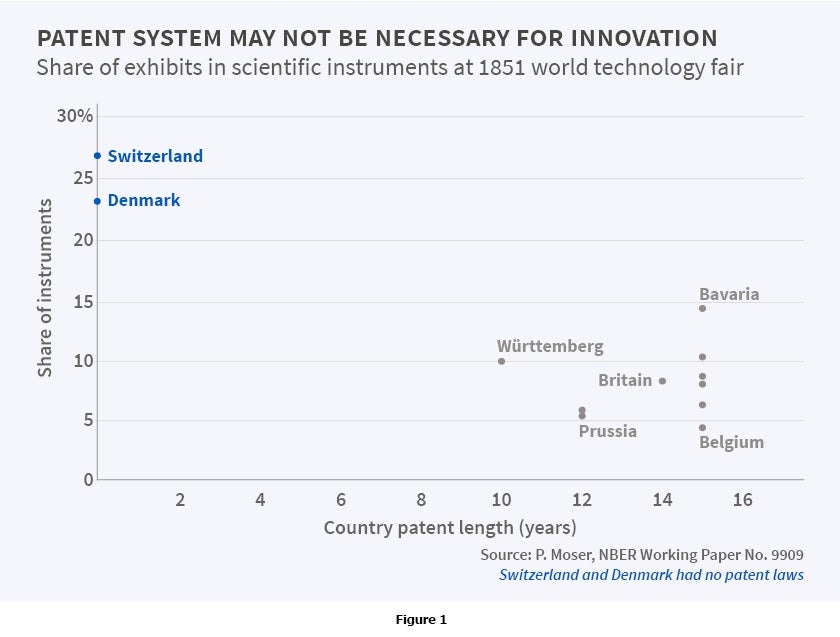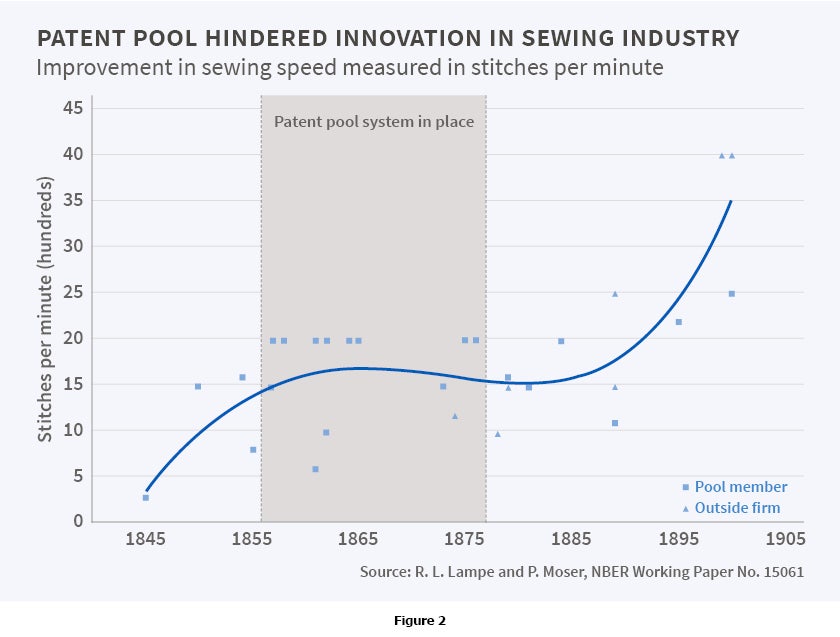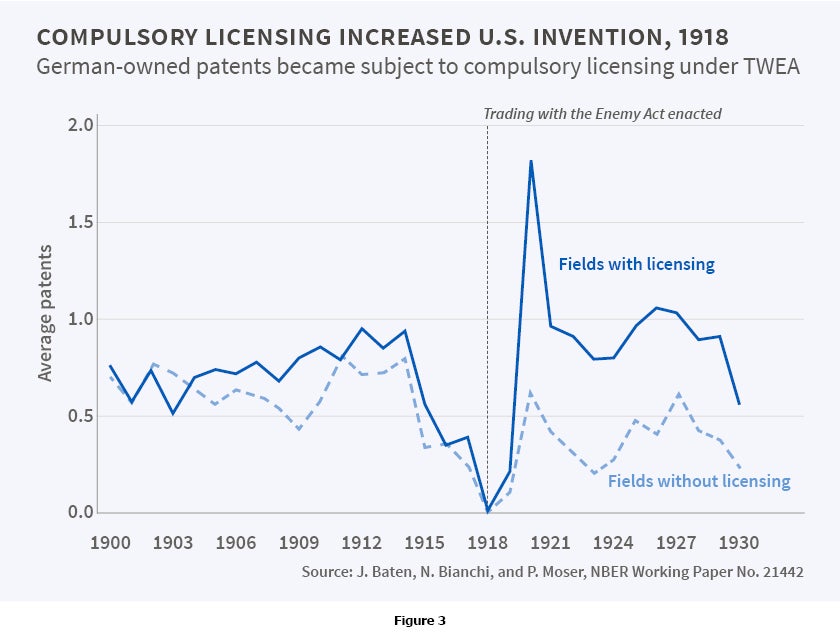Determinants of Creativity and Innovation: Evidence from Economic History
Innovation and creativity are the primary source of improvements in human welfare. Yet, due to two major empirical challenges, it is difficult to determine the factors that encourage creativity and innovation. First, modern settings often lack clean experimental variation, because policies designed to encourage innovation adapt in response to lobbying, which makes it difficult to identify causal effects. Second, innovation and creativity are exceedingly hard to measure. For example, patent counts are the standard measure of innovation, but they fail to capture important innovations that occur outside of the patent system, for example in countries without patent laws. Excluding such developments may distort economists' views on the determinants of innovation.
My research addresses these identification and measurement challenges by exploiting a wealth of historical events that changed intellectual property laws and other policies independently of changes in innovation. In practice, this research approach combines in-depth analyses of historical records with statistical tests of large data sets. For example, I exploit a large amount of credibly exogenous variation in national patent laws in the 19th century–before interest groups had begun to lobby for changes in patent policy–to analyze data on innovations with and without patents that were exhibited at world fairs.1 Complementary research uses the Nazi's decision to dismiss all Jewish scientists to examine the effects of high-skilled immigrant scientists on U.S. innovation.2 Another project exploits variation in the timing of Napoleon's military victories to examine the effects of copyrights on Italian opera.3
Does Existence of a Patent System Encourage Innovation?
My research addresses a central question in economic history: Has the creation of property rights in ideas encouraged innovation and economic growth? A strong tradition argues that secure property rights built the foundation for the industrial revolution in Britain and the United States.4 Innovation is, however, a cumulative process and strong property rights for early generations of inventors reduce payoffs for those in later generations.5 These costs are particularly severe if patents are broad and their boundaries uncertain, so that later generations are continuously at risk of infringing on existing patents. Recent patent wars over smart phones and tablet computers have moved these issues to the forefront of policy debates, but the underlying tensions are more general. My research exploits historical variation in 19th century patent laws–when countries such as Switzerland and the Netherlands had not yet adopted patent laws or had abolished them for political reasons–to investigate the effects of patent laws on innovation.
To measure effects on innovation, I construct historical data sets to capture innovations that occur within and outside of the patent system. Patent data fail to capture all such innovations, which compromises their use in empirical analyses of the effects of patent laws. To address this major data constraint, I have used exhibition catalogues for the 1851 world technology fair in London [Figure 1] and the 1876 U.S. Centennial Exhibition in Philadelphia to collect detailed historical information on nearly 20,000 innovations with and without patents, including their industries, locations, and whether they won a prize for being particularly innovative.
These data indicate that the existence of a national patent system may not be necessary to encourage innovation. In 1851, for example, Switzerland contributed twice as many exhibits per capita as the other European countries, and won a disproportionate number of prizes for being especially innovative, even though it had no patent system. Exhibition data show that only a small share of innovations were patented,6 calling into question the role of patents in encouraging the Industrial Revolution. In 1851, just 11 percent of British exhibits and 15 percent of U.S. exhibits were patented.
The exhibition data also indicate that the share of innovations covered by patents varied significantly across industries. Fewer than 5 percent of Britain's chemical exhibits in 1851 and 10 percent of scientific instruments were patented, compared with 20 percent of manufacturing machinery. Remarkably, U.S. inventors relied on and avoided patents in the same industries as British inventors despite vast differences in national patent laws.
Rather than increasing the number and the quality of innovations, patents appear to influence the direction of technical change. Exhibition data reveal that innovations in countries without patent laws were concentrated in a narrow set of indus-tries, such as scientific instruments, food processing, and chemicals, where innovations were difficult to reverse engineer, so that secrecy offered an effective mechanism to protect intellectual property.7
Scientific breakthroughs, such as the development of the periodic table, which reduced the effectiveness of secrecy, created an exogenous shift towards patenting in chemicals without affecting other industries. I exploit this shift to examine historical data on the geographic location of innovations and workers. This analysis indicates that shifts toward patenting can encourage the diffusion, if not the level, of inventive activity.8
Complementary research on incentive prizes, which links exhibits with patents and the records of the Scientific American, the premiere science journal of the time, shows that prizes can be an effective alternative to patents, if they publicize promising research ideas.9 Extensions of this research examine the role of intellectual property rights in encouraging biological innovation,10 and use field trial data to measure variation in the size of patented inventions.11
Patent Pools and Compulsory Licensing
If patent laws fail to encourage innovation, can they be modified to become more effective? One potential mechanism to reduce litigation risks is the creation of a patent pool, in which firms combine patents for complementary parts of the same technology; pool members can then license all patents as a package to outside firms. In recent years, pools have formed across many technologies, ranging from tablet computers to diagnostic kits for breast cancer. Yet their effects on innovation are poorly understood. My research with Ryan Lampe uses the example of the first patent pool in U.S. history, the Sewing Machine Combination (1856–77) to examine the effects of a pool on the creation of new technologies. An analysis of patents, firm entry, and quantitative measures for improvements in sewing speed suggest that innovation declined with the formation of the pool.12 [Figure 2] We also find that the creation of a pool can divert R&D towards inferior technologies that allow non-members to avoid direct competition with the pool. These effects are particularly severe if pools increase litigation risks for non-members or if they create a system of differential license fees that put members at a disadvantage.13 Both of these traits are common features in modern pools. These findings are confirmed in a large-scale analysis of 20 pools that formed under the New Deal.14
Another prominent policy mechanism is compulsory licensing, which allows governments to license foreign-owned patents to domestic firms without the consent of foreign patent owners. Emerging economies, such as India, Brazil, and Thailand have used this policy to improve access to HIV medications and other essential innovations covered by foreign-owned patents. Because of its potentially significant implications for consumer welfare, compulsory licensing is one of the most controversial topics in intellectual property policy today. Yet, there is almost no systematic, empirical evidence on the effects of compulsory licensing. My research with Alessandra Voena provides such evidence by exploiting an exogenous episode of compulsory licensing in 1918, when the United States decided to subject all enemy-owned patents to compulsory licensing. [Figure 3] In the United States, compulsory licensing led to a 20 percent increase in patenting by domestic inventors, who were allowed to produce and improve German-owned technologies.15 Notably, compulsory licensing also encouraged invention in Germany, possibly by increasing the threat of entry in research fields that had been dominated by a small number of firms.16
Émigré Scientists and U.S. Innovation
Along with intellectual property rights, science and immigration policies are critical levers that help determine innovation. Biographical evidence suggests that German Jewish scientists who fled Nazi Germany revolutionized American science. In physics, émigrés such as Edward Teller and Hans Bethe formed the core of the Manhattan Project, but due to the strategic nature of their work, it is impossible to quantify their contributions. In chemistry, patents are an effective mechanism to protect intellectual property, and patent counts create a useful proxy for changes in innovation. An analysis of historical patents suggests that U.S. invention increased by 31 percent in fields in which émigrés were active inventors.17 New inventor-level data indicate that émigrés encouraged U.S. invention by training younger scientists and by attracting U.S. scientists to research in émigrés' fields.
Can Copyrights Encourage Creativity?
Another alternative policy mechanism is the copyright, which creates much narrower property rights than a patent and may thereby avoid many problems with the current patent system. However, systematic empirical evidence on copyrights is scarce due to a lack of experimental variation and to severe selection problems. At copyright lengths of 95 years for corporate owners, modern copyrights are extremely long-lived, which implies that commercially viable works that are off copyright today are an extremely selected sample of durable works. Nicknames for modern laws, such as the 1998 "Mickey Mouse Protection Act" bear witness to intense lobbying, which makes it difficult to disentangle the causal effects of copyright policies and other forces that may affect innovation.
My research with Xing Li and Megan MacGarvie addresses these issues by exploiting historical variation in copyrights. Our analysis of copyrights in literature exploits an unintended differential increase in the length of U.K. copyrights in 1814–in favor of dead authors–to examine the effects of longer copyrights on book prices in Romantic Period England.18 We show that extensions in the length of copyright protection led to a significant increase in the price of books by dead authors. Archival data on contract negotiations show that payments to authors also increased after 1814, suggesting that copyright protection can benefit authors.19
To examine the effects of copyright on creativity, Michela Giorcelli and I exploit variation in the timing of Napoleon's military victories to examine the effects of copyright protection on the production of Italian operas.20 Italian states that came under French influence by 1801 adopted French copyright laws, while states that came under French influence after 1804, when France's parliament adopted its code civil, did not adopt copyright laws. Giorcelli and I find that composers produced substantially more operas after the adoption of copyright laws. Composers also began to produce higher-quality operas, as measured through both historical popularity and longevity. Interestingly, the data yield no evidence that copyright extensions encourage creativity.
Endnotes
P. Moser, "How Do Patent Laws Influence Innovation? Evidence From Nineteenth-Century World's Fair," NBER Working Paper 9909, August 2003, and American Economic Review, 95(4), 2005, pp. 1214-36.
P. Moser, A. Voena, and F. Waldinger, "German-Jewish Émigrés and U.S. Invention," NBER Working Paper 19962, March 2014, and American Economic Review, 104(10), 2014, pp. 3222–55.
M. Giorcelli and P. Moser, "Copyright and Creativity: Evidence from Italian Operas," Working Paper, 2015. http://ssrn.com/abstract=2505776.
D. C. North and R. P. Thomas, The Rise of the Western World: A New Economic History, New York, NY: Cambridge University Press, 1973; and N. Lamoreaux and K. Sokoloff, "Inventive Activity and the Market for Technology in the United States, 1840–1920," NBER Working Paper 7107, May 1999.
S. Scotchmer, "Standing on the Shoulders of Giants: Cumulative Research and the Patent Law," Journal of Economic Perspectives, 5(1), 1991, pp. 29–41.
P. Moser, "Why Don't Inventors Patent?" NBER Working paper 13294, August 2007, and Journal of Law and Economics, (published as "Innovation without Patents: Evidence from World's Fairs") 55(1), 2012, pp. 43–74.
P. Moser, "How Do Patent Laws Influence Innovation? Evidence from a Nineteenth-Century World's Fair," NBER Working Paper 9909, August 2003, and American Economic Review, 95(4), 2005, pp. 1214–36.
P. Moser, "Do Patents Weaken the Localization of Innovations? Evidence from World's Fairs," Journal of Economic History, 71(2), 2011, pp. 363–82.
P. Moser and T. Nicholas, "Prizes, Publicity, and Patents: Non-Monetary Awards as a Mechanism to Encourage Innovation," Journal of Industrial Economics, 61(3), 2013, pp. 763–88.
P. Moser and P. Rhode, "Did Plant Patents Create the American Rose?" NBER Working Paper 16983, April 2011, and in J. Lerner and S. Stern, eds., The Rate and Direction of Inventive Activity Revisited, Chicago, Illinois: University of Chicago Press, 2012, pp. 413-38.
P. Moser, J. Ohmstedt and P. Rhode, "Patent Citations and the Size of the Inventive Step–Evidence from Hybrid Corn," NBER Working Paper 21443, July 2015.
R. Lampe and P. Moser, "Do Patent Pools Encourage Innovation? Evidence from the 19th-Century Sewing Machine Industry," NBER Working Paper 15061, June 2009, and The Journal of Economic History, 70(4), 2010, pp. 898–920.
R. Lampe and P. Moser, "Patent Pools and the Direction of Innovation–Evidence from the 19th-century Sewing Machine Industry," NBER Working Paper 17573, November 2011, and "Patent Pools and Innovation in Substitute Technologies–Evidence from the U.S. Sewing Machine Industry," RAND Journal of Economics, 44(4), 2014, pp. 757–78.
R. Lampe and P. Moser, "Do Patent Pools Encourage Innovation? Evidence from 20 U.S. Industries under the New Deal," NBER Working Paper 18316, August 2012.
P. Moser and A. Voena, "Compulsory Licensing–Evidence from the Trading with the Enemy Act," NBER Working Paper 15598, December 2009, and American Economic Review, 102(1), 2012, pp. 396–427.
J. Baten, N. Bianchi, and P. Moser, "Does Compulsory Licensing Discourage Invention? Evidence from German Patents after WWI," NBER Working Paper 21442, July 2015.
P. Moser, A. Voena, and F. Waldinger, "German-Jewish Émigrés and U.S. Invention," NBER Working Paper 19962, March 2014, and American Economic Review, 104(10), 2014, pp. 3222–55.
X. Li, M. MacGarvie, and P. Moser, "Dead Poets' Property–How Does Copyright Influence Price?" NBER Working Paper 21522, September 2015.
M. MacGarvie and P. Moser, "Copyright and the Profitability of Authorship: Evidence from Payments to Writers in the Romantic Period," NBER Working Paper 19521, October 2013, and in A. Goldfarb, S. Greenstein, and C. Tucker, eds., Economic Analysis of the Digital Economy, Chicago, IL: University of Chicago Press, 2015, pp. 357–79.
M. Giorcelli and P. Moser, "Copyright and Creativity: Evidence from Italian Operas," Working Paper, 2015. http://ssrn.com/abstract=2505776.





